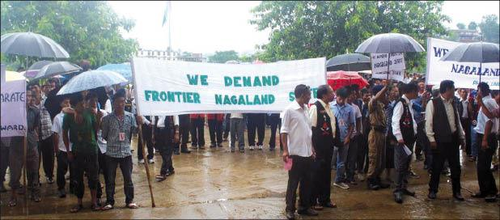Kohima: Ahead of every election in Nagaland, the Naga political issue becomes a key topic dominating the election campaign, but this time before the parliamentary polls, the statehood issue has turned out to be the main agenda in the state.
The Eastern Nagaland People’s Organisation (ENPO), which has been demanding a separate administration or state comprising six backward Nagaland districts since 2010, remains firm on boycotting the April 19 elections to the lone Lok Sabha seat in the state unless their demands are met, despite the appeals from the state government and various other parties.
The ENPO, and its seven sister organisations, told the Election Commission that they have resolved that unless the separate state demand was met by the Centre, they would not participate in any Lok Sabha or state elections.
Given the ENPO’s agitation and call to boycott the Lok Sabha polls, Chief Minister Neiphiu Rio on Thursday held a meeting with officials of the eastern Nagaland region.
The ENPO, agitating in support of its demand since March 8, has imposed a “public emergency”, and its sister organisations are not allowing any election campaign in the six districts bordering Myanmar.
Of Nagaland’s 16 districts, seven backward tribes — Chang, Khiamniungan, Konyak, Phom, Tikhir, Sangtam, and Yimkhiung are living in these six eastern districts — Kiphire, Longleng, Mon, Noklak, Shamator, and Tuensang.
The six districts account for 20 of the state’s 60 Assembly seats. The demand for a new state is due to the development deficit, and its creation will ensure development, the ENPO claimed.
“If the six most backward districts upgraded as a separate state, it would ensure development of the region. Among the Nagas, we have two groups — one backward Naga and another advanced,” said C.L John, an MLA from eastern Nagaland. He said their demand for a separate state is for the all-round development and welfare of the Nagas living in the eastern part of the state.
The eastern Nagaland region was included under the North East Frontier Agency, set up in the British era. The region merged with the Naga Hills District of Assam in 1957 and was administered by the Governor of Assam on behalf of the Ministry of External Affairs (MEA).
The region became a part of Nagaland in 1963 when it became a full-fledged state.
After boycotting the 10-day long 23rd edition of the famous ‘Hornbill Festival’ in December 2022, the ENPO, the apex Naga body, and its associated organisations, in support of its separate state demand, gave a call to boycott last year’s Assembly polls (February 27) but later withdrew it following an assurance from Union Home Minister Shah.
The Union Ministry of Home Affairs (MHA), responding to the ENPO’s demand, last year formed a three-member committee, headed by Adviser, Northeast, A.K. Mishra to study their demand, and the panel visited Nagaland several times and talked with all stakeholders.
Chief Minister Rio, who is sympathetic towards the demand of the ENPO, recently said that the state government has already recommended, to the Centre, that an autonomous region be set up for the people belonging to the eastern region.
On March 28, a closed-door meeting was held between the Eastern Nagaland Legislative Union (ENLU), a body of 20 MLAs representing the six backward districts and ENPO. But after the crucial nine-hour-long meeting, the ENPO leaders reiterated their call to boycott the April 19 Lok Sabha elections.
The BJP, a part of the United Democratic Alliance government in Nagaland, has urged the ENPO to hold dialogue with the government to resolve their demand for a separate state.
(Sujit Chakraborty can be contacted at sujit.c@ians.in)
–IANS


Comments are closed.